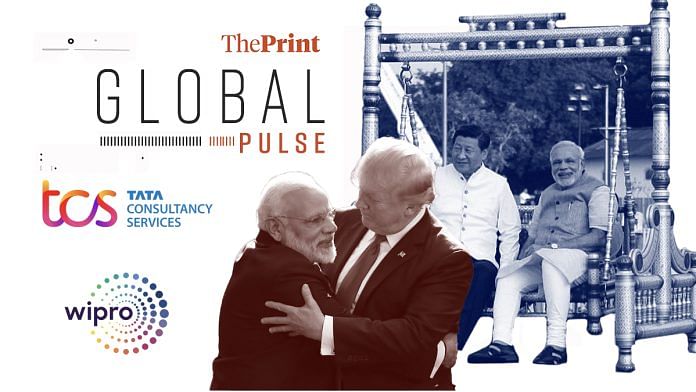New Delhi: Before US President Donald Trump, PM Modi had “rolled out the red carpet” for Xi Jinping—which included sharing a swing by the Sabarmati. But the “several acts of aggression” which followed left Modi embarrassed. His relationship with Trump appears to have followed the same playbook. Modi pulled out all stops for Donald Trump and what he got in return was “public humiliation”—a “whopping” 50 percent trade tariff and a devastating statement where Trump called India a “dead” economy. All of this has “plunged India into a moment of soul searching, write Mujib Mashal and Hari Das in The New York Times.
“India’s ambition to consolidate its rise as an economic and diplomatic force appears deflated by the sudden uncertainty,” reads the report. “Stuck between two superpowers that have shown no hesitation to put India down in moments of friction, there is a growing sense among Indian officials and experts that the country will have to firmly return to its long-tested doctrine of strategic autonomy.”
Pulling India away from Russia, even with the threat of “stiff tariffs” is no mean feat. Modi has “stood firm in the face of rising American pressure”, report Shan Li and Thomas Grove in the Wall Street Journal, diving into how crucial the India-Russia partnership really is.
“Russia has been one of India’s most constant partners in a relationship anchored by arms deals, economic cooperation and diplomatic support for New Delhi as it faces off with regional rivals China and Pakistan. For its part, Moscow drew close to India after tensions grew in the 1960s between the Soviet Union and Beijing,” reads the report.
“He (Trump) is completely upset with India”—Mukesh Aghi of the US-India Strategic Partnership tells Politico. A critical, burgeoning relationship is now in jeopardy. Trump’s “focus shifted” from India to the EU and a much-touted trade deal never came, report Daniel Desrochers and Megan Messerly in Politico.
“For months, it seemed as if the White House was ready to announce a deal with India. One person close to the Trump administration, granted anonymity to share details of private conversations, said they understood that a trade accord had been done for several weeks. Indian officials were convinced that an early agreement was only waiting for Trump’s approval. The president himself said he believed a deal with India was imminent,” according to the report.
Indian tech powerhouses like TCS and Wipro are “racing to reinvent themselves” in the face of AI, low-sector growth and a “Trump-Bump”—all of which stand to fundamentally alter the giants, report Chris Kay, Krishn Kaushik, John Reed and Patrick Jenkins in the Financial Times.
“The US president’s trade battles—including a 50 percent tariff slapped on India that nevertheless excludes services—have delayed business decision-making and investment,” they write.
“Sector growth has been in the low single digits for the past two years, according to HSBC, which last month attributed the sluggishness to economic uncertainty, competition from corporate in-house global capability centres being set up rapidly across India, as well as ambiguity over the impact of generative AI,” says the report, adding that the major players are “keenly aware that AI is a double-edged sword”.
Also in the Financial Times, Susannah Savage reports that in a massive blow to farmers in India, global rice prices have hit an all time low. There is simply “too much stock”, according to Samarendu Mohanty, director of the Centre for Sustainable Agriculture and Development Studies at Professor Jayashankar Telangana State Agricultural University.
“India’s rice production last year was a record… The crop they just planted is going to be another record crop,” he told the FT.
What was ostensibly a crackdown on migrants turned into “an arbitrary campaign of fear against Muslims in India,” report Saif Hasnat and Pranav Bhakar in The New York Times, referring to scores of people who were detained as part of “verification drives”—including in “Gurugram, a satellite city of the capital”.
“The Indian government has had to readmit dozens of people who proved their Indian citizenship after being expelled across the border, according to a report released in July by Human Rights Watch. The government’s crackdown has largely targeted Muslim migrant workers from impoverished backgrounds,” says the report.
(Edited by Viny Mishra)
Also read: Modi’s ready to risk it all for farmers. Farm reform can answer Trump with new Green Revolution






